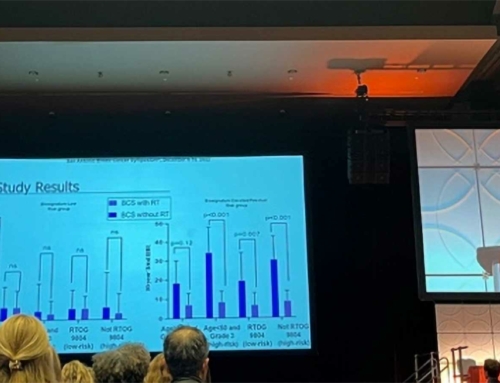“DCISionRT testing changes RT recommendations substantially by both safely omitting and adding post-operative RT, thus minimizing over-and undertreatment of DCIS patients.”
Troy Bremer, PhD; Pat Whitworth, MD; Chirag Shah, MD; Anne Peled, MD; and Karen Barbosa, DO, FACOS discuss the recently published SweDCIS data and how they are utilizing DCISionRT in clinical practice.
As an introduction, Dr. Bremer outlined the challenge of overtreatment with radiation therapy for ductal carcinoma in situ (DCIS) patients where 80% of patients won’t recur following breast conserving surgery (BCS), yet 80 – 90% of women with DCIS get treated with radiation therapy following breast conserving surgery (BCS). “This unnecessary radiation is not only a high cost to the health system, but substantially impacts quality of life for women with DCIS. Therefore, we really need to be defining which patients need radiation.”
“Our latest data from the SweDCIS study demonstrates that the DCISionRT test is predictive, provides personalized results, and is superior to clinpath, providing greater confidence in treatment decisions. Our esteemed panel will be discussing how they utilize the test for risk assessment upfront and later from an adjuvant therapy perspective to determine who needs additional therapy beyond BCS.”
Dr. Whitworth explained, “we now know clinicopathology factors alone do not work to assess risk of recurrence or predict benefit from RT. This has been confirmed in multiple studies with 40% of physicians changing their RT recommendation based on the DCISionRT score. From a breast surgeon perspective, this translates into patients with a low-risk Decision Score being able to safely omit RT today and retain the option for radiation down the road, if needed. This is especially important for younger patients who have a 15 – 20% likelihood for a 2nd primary breast cancer. I also see women who would rather have a mastectomy than RT and DCISionRT gives my patient and myself the confidence to make a personalized treatment decision based on a quantitative score.”
Next, we get the assessment of a radiation oncologist. Dr. Shah reiterated that traditional clinicopathologic features have failed to identify a low-risk cohort suitable for omission of RT. He explained that the SweDCIS data confirms that DCISionRT identifies the individual benefit of radiation for each patient. “For low-risk patients, there is essentially no benefit to radiation therapy. Conversely, in the elevated risk group, there is a substantial benefit to RT and a substantial benefit from invasive recurrences, which is what we really worry about in DCIS patients. It’s important to note that the goal is not to omit radiation, but tailor radiation therapy to the patients’ biology specifically.”
Dr. Shah concluded, “A key synopsis for me is that DCISionRT testing changes RT recommendations substantially by both removing and adding post-operative RT, thus minimizing over-and undertreatment of DCIS patients.”
Dr. Peled, oncologic breast surgeon, discussed the patient journey following initial DCIS diagnosis and shared several patient case studies. “The patient discussion surrounding DCIS is pretty complicated because there are a variety of treatment options available to the patient – lumpectomy, mastectomy, oncoplastic reconstruction, post-mastectomy reconstruction. So, having the DCISionRT test results from the biopsy is incredibly helpful in facilitating discussions and treatment decision making with the multi-disciplinary team. We understand that each patient has a different risk tolerance so having the continuous risk score allows for personalized risk assessment.
Dr. Karen Barbosa, oncoplastic surgeon, concluded the presentation with a discussion of how to integrate DCISionRT into clinical practice. “At medical conferences today, de-escalation is the new standard of care. So, it is exciting to have a test that can provide precision medicine decision making for individual patients that we can leverage in our practice. With DCISionRT, we are treating the patients who will benefit significantly from RT and safely omitting RT for those who will not benefit.”
For additional information on the randomized SweDCIS study, clinical information on DCISionRT, and how surgeons and radiation oncologists are implementing it into their practices, click here to watch the webinar bit.ly/3KJXeKu.






